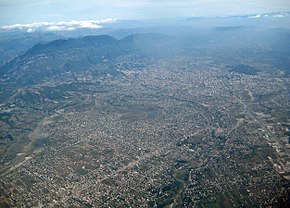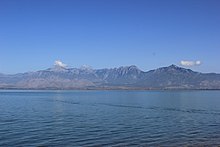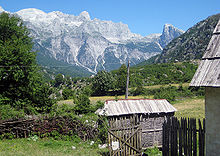Albania
![]()
The title of this article is ambiguous. For other meanings, see Albania (disambiguation).
Template:Infobox State/Maintenance/NAME-German
Albania (Albanian indefinite: Shqipëri, definite: Shqipëria), officially the Republic of Albania (Albanian Republika e Shqipërisë), is a state in southeastern Europe on the Balkan Peninsula. Its territory is bordered by Montenegro and Kosovo to the north, northern Macedonia to the east, and Greece to the south. The natural western border is formed by the coasts of the Adriatic and Ionian Seas, making the country one of the littoral states of the Mediterranean Sea. The capital and largest city of the country is Tirana.
Albania is a democratic parliamentary republic. According to the United Nations Human Development Index, Albania is one of the most developed countries in the world. Since the end of communism, significant steps have been taken to improve the economic and social situation. Despite all the progress, Albania was still one of the poorest countries in Europe in 2017. However, drug cultivation and smuggling generate significant revenues, and the country was considered a major supplier of certain drugs to the European Union in early 2019.
The country is a member of the United Nations, NATO, the OSCE, the Council of Europe, CEFTA, the Regional Cooperation Council, the Black Sea Economic Cooperation and the Organization of Islamic Cooperation. Albania has also been a candidate country for membership of the European Union since 24 June 2014. It is also a member of the World Trade Organization and the World Bank.
Geography
→ Main article: Geography of Albania
Overview
With an area of 28,748 square kilometres, Albania is slightly smaller than Belgium and has 2.8 million inhabitants, slightly more than Schleswig-Holstein.
Albania's coast on the Adriatic and Ionian Sea is 362 kilometres long. At the narrowest point of the Adriatic - the Strait of Otranto - it is only 73 kilometres from Italy, and at the village of Ksamil only two kilometres from the Greek island of Corfu. There are countless natural sand and pebble beaches along the coast. Well-known resorts are Velipoja, Shëngjin, Durrës and Vlora on the Adriatic Sea and Dhërmi, Himara and Saranda on the Ionian Sea.
The land border with Montenegro and Kosovo (or Serbia) is 287 kilometres long, that with Greece 282 kilometres and that with northern Macedonia 151 kilometres.
Like the whole Mediterranean region, Albania is located in a tectonically very active region. Severe earthquakes have occurred repeatedly, for example in 1967, 1979 and 2019.
Natural classification
See also: List of the highest mountains in Albania
About half of Albania's territory is occupied by mountainous areas with altitudes above 600 m above sea level. A small part of it are high mountain regions. From Lake Scutari in the north to Vlora in the south, alluvial soils, some of which are only a few kilometres wide, extend along the coast to form the great Myzeqe plain in central Albania. There are numerous lagoons and wetlands along the coast.
Only the valleys, the hill country, parts of the coastal plain and some plateaus allow dense human settlement. There the population density is relatively high, while other parts of the country are sparsely populated.
In the north of the state are the Northern Albanian Alps, which belong to the Dinarides. The highest mountain in Albania is Korab, 2764 m above sea level, northeast of Peshkopia right on the border with northern Macedonia. Another high and well-known mountain is Jezerca. This is with 2694 m above sea level the highest mountain lying completely in Albania.
Waters
See also: List of lakes in Albania and List of rivers in Albania
All of Albania's major rivers flow into the Adriatic Sea. With a length of 282 kilometres, the Drin is the longest river in the country. The Black Drin has its source in Lake Ohrid. At Kukës in northern Albania, it joins the White Drin, which comes from Kosovo. The (United) Drin then flows westward through several large reservoirs and joins the Buna at Shkodra. The other larger Albanian rivers Mat, Shkumbin, Seman with Devoll, and Vjosa (in their naming from north to south) flow more or less directly westward toward the Adriatic, all breaking through various mountain ranges. The short Buna drains Lake Shkodra into the Adriatic, forming in places the border with Montenegro.
Climate
Albania has a subtropical-Mediterranean winter rainfall climate (Mediterranean climate) with an average annual temperature of 16 °C and a total annual precipitation of just under 1200 millimetres.
In Tirana, two summer months are arid. In the northern and eastern mountainous regions, winters are harsh; even in summer it can get quite chilly there. In winter, many places in these areas are cut off from the outside world for months because of snow. In the south, on the Ionian Sea, the climate is much milder. In the coastal regions, precipitation is high in winter. In Saranda, almost 300 sunny days are recorded annually.
Cities
→ Main article: List of cities in Albania
Cities have existed on the territory of Albania for over 2600 years. One of the oldest is Durrës, founded in 627 BC. Today, a slight majority of the population (54%) lives in cities. The largest of these are in the western coastal lowlands. They have grown rapidly since the last decade of the 20th century, while smaller towns have lost inhabitants. Tirana in particular has expanded far into the surrounding countryside due to the strong rural exodus in the 1990s and today forms a metropolitan region together with suburbs and Durrës.
| Rank | City | Inhabitants | Qark |
| 01. | Tirana | 557.422895 | Tirana |
| 02. | Durrës | 175.110 | Durrës |
| 03. | Elbasan | 141.714 | Elbasan |
| 04. | Shkodra | 135.612 | Shkodra |
| 05. | Fier | 120.655 | Fier |
| 06. | Vlora | 104.827 | Vlora |
| 07. | Kamza | 104.190 | Tirana |
| 08. | Lushnya | 83.659 | Fier |
| 09. | Korça | 75.994 | Korça |
| 010. | Lezha | 65.633 | Lezha |

The capital Tirana experienced a population growth of over 100 % between 1991 and 2001. In the picture: Aerial view of Tirana with the suburb Kamza (2008)

Climate diagram of the capital Tirana
.jpg)
Morning atmosphere at the Koman reservoir in northern Albania

Bay of Ksamil with the four islands

Lake Scutari near Shkodra in the north of Albania
Nature and environment
Albania has a rich biodiversity while struggling with a number of environmental problems, including overgrazing, illegal logging, poaching for fishing and hunting, and overfishing. In 2002, 3.6% of the country's land was protected; in 2010, 9.9% was. Albania is part of the European Green Belt and lies in the Blue Heart of Europe.
flora and fauna
→ Main article: Flora and vegetation of Albania
The country is located in a region rich in species, especially many plant species. The Albanian flora counts over 3221 species. Of these, 489 are endemic to the Balkan Peninsula and 40 species are found only in Albania. Palm, orange and lemon trees grow in the lowlands. The river valleys, deeply carved into the mountainous terrain, are lined with walnut and almond trees. In the forests in the north, fir, spruce, oak, beech and maple trees, among others, thrive. Oak forests are particularly typical and make up one fifth of the Albanian forests. In the warmer south and in the coastal plains grow mainly pine, lime and olive trees. Macchia are common up to an altitude of 800 m above sea level, along with eucalyptus, fig and laurel trees.
With many undeveloped areas, the country provides habitat for a variety of rare bird species and other animals that have disappeared elsewhere in the region. The remote mountain areas are home to wolves, the last of the critically endangered Balkan lynxes and foxes; deer, feral domestic goats and wild boar are also common. Brown bear numbers are said to have been severely depleted in the late 1990s. In addition, Albania has more than 350 native bird species. These include eagles, falcons and kites, among others. The large coastal wetlands, especially the lagoons of Karavasta, Narta and Butrint, as well as inland lakes, are important stopovers for many migratory birds. In Albanian waters there are about 260 species of salt and freshwater fish, as well as green turtles and hawksbill turtles.
In the 25 years following the collapse of the communist regime, a decline in biodiversity has been observed in Albania. Two plant and four mammal species have become extinct. A population decline of more than half was documented for 27 mammal species, 89 bird species, six fish species and four plant species. To protect the endangered wildlife, the government imposed a hunting ban for two years in early 2014. In 2016, the hunting ban was extended until 2021. In February 2016, a ten-year ban on logging was also imposed. However, according to the Tirana-based magazine Exit, the logging ban has no effect, as newly cleared areas are automatically classified as "agricultural land" in the zoning plan.
National Parks
There are 14 national parks in Albania, covering about 6.9% of the national territory, and the Karaburun-Sazan Marine Protected Area. The largest are the Hotova-Dangell National Park, the Shebenik-Jablanica National Park and the Dajti National Park. The parks are refuges for numerous plants and animals and harbor pristine landscapes. However, there is a lack of practical and effective protection of the areas. Individual national parks are popular tourist destinations.
Pollution
In 2004, Albania was considered the most polluted country in Europe. Emissions and contaminated sites pollute water, groundwater, soil and air, especially in densely populated regions.
This is partly due to inadequate waste management, including widespread burning of all types of waste and illegal dumping, and the sale of substandard fuels. There were only two landfills that met EU standards in 2013. Much waste is dumped on riverbanks or in fields. Nevertheless, garbage is imported. In 2011, waste import was allowed by the then Berisha government, but in 2013 the new Rama government reversed the relevant law. In the summer of 2016, the law was unexpectedly re-enacted. Moreover, the new garbage import law is much more permissive than the original 2011 law.
Many of the passenger cars operating in Albania have diesel engines. Like the trucks, many of them are old and poorly maintained. Most of the vehicles were imported as used cars.
In 2014, the Ministry of Environment published a comprehensive report on the state of the environment in Albania. It indicates that progress has been made in some areas, while in others there is still a high need for improvement.
- Air pollutionWhile the
levels of sulphur dioxide, ozone and nitrogen dioxide were below the EU permitted levels at all seven monitoring stations, the average annual levels of particulate matter were in some cases of concern (the EU permitted annual mean is 40 μg/m³): - Tirana (southern city centre at the National Environment Agency): 65 μg/m³.
- Tirana (eastern city centre near the Ministry of Environment): 45 μg/m³.
- Durrës: 15 μg/m³
- Shkodra: 22 μg/m³
- Elbasan: 47 μg/m³
- Vlora: 15 μg/m³
- Korça: 38 μg/m³
- Noise
pollutionAlbanian cities have a higher than average noise pollution. The average maximum values in Tirana were measured at the Rruga e Elbasanit with 74.3 dB during the day and at the University Hospital Mother Teresa with 63.3 dB at night. At the same time, noise pollution in the capital has decreased at almost all measuring stations since 2007. The EU approved values are 55 dB during the day and 45 dB at night. The following values were measured in 2014: - Tirana: 67.9 dB (day), 57.3 dB (night)
- Fier: 60.9 dB, 48.5 dB
- Vlora: 62.2 dB, 50.4 dB
- Saranda: 62,3 dB, 46,1 dB
- Korça: 61.9 dB, 43 dB
- Water pollution measurements in
2014 confirmed the values of recent years: water pollution is highest in urban rivers, i.e. in the Lana, the Ishëm, the Tirana River and the Gjanica. All these rivers exceeded the EU permitted levels of phosphorus and ammonium. Of the larger rivers, only the Mat and the Vjosa have good to very good water values. The river systems of Ishëm, Erzen, Seman, Drin and Buna are in poor condition. The Shkumbin has moderately negative water values. In addition, the water quality of most beach sections at Kavaja and Durrës is very low. - Waste disposal
Albania has made great progress in waste disposal. As of 2014, there were five official landfills (Tirana, Shkodra, Saranda, Rrëshen and Bajram Curr), and another was under construction near Korça.

In the Northern Albanian Alps near Theth: the mountain peaks Radohima and Arapi

The golden eagle (Albanian Shqiponja) - a symbol of Albania
Questions and Answers
Q: What is the official name of Albania?
A: The official name of Albania is the Republic of Albania.
Q: What is the capital city of Albania?
A: The capital city of Albania is Tirana.
Q: What are some other important cities in Albania?
A: Other important cities in Albania include Durrës, Elbasan and Vlora.
Q: How many people live in Albania?
A: Over 3 million people live in Albania.
Q: What religions are practiced by Albanians?
A: The majority of Albanians practice Islam (55%), Eastern Orthodox (23%) and Roman Catholicism (15%).
Q: Which countries border with Albania?
A: Countries that border with Albania include Montenegro, Kosovo, North Macedonia and Greece.
Q: What are the two seas that border with Albania?
A: The two seas that border with Albania are the Adriatic Sea in the west and Ionian Sea in the southwest.
Search within the encyclopedia